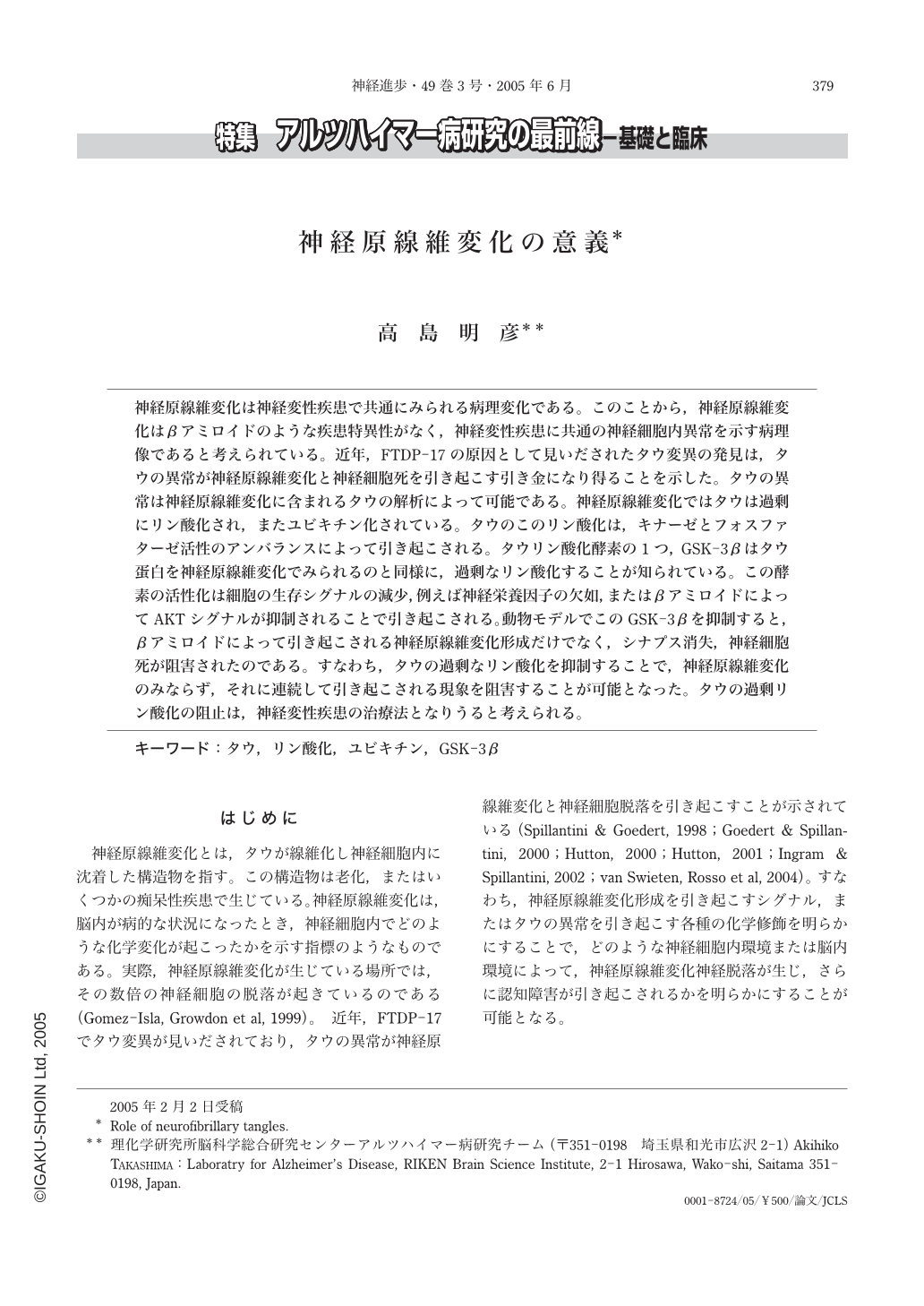Japanese
English
- 有料閲覧
- Abstract 文献概要
- 1ページ目 Look Inside
神経原線維変化は神経変性疾患で共通にみられる病理変化である。このことから,神経原線維変化はβアミロイドのような疾患特異性がなく,神経変性疾患に共通の神経細胞内異常を示す病理像であると考えられている。近年,FTDP-17の原因として見いだされたタウ変異の発見は,タウの異常が神経原線維変化と神経細胞死を引き起こす引き金になり得ることを示した。タウの異常は神経原線維変化に含まれるタウの解析によって可能である。神経原線維変化ではタウは過剰にリン酸化され,またユビキチン化されている。タウのこのリン酸化は,キナーゼとフォスファターゼ活性のアンバランスによって引き起こされる。タウリン酸化酵素の1つ,GSK-3βはタウ蛋白を神経原線維変化でみられるのと同様に,過剰なリン酸化することが知られている。この酵素の活性化は細胞の生存シグナルの減少,例えば神経栄養因子の欠如,またはβアミロイドによってAKTシグナルが抑制されることで引き起こされる。動物モデルでこのGSK-3βを抑制すると,βアミロイドによって引き起こされる神経原線維変化形成だけでなく,シナプス消失,神経細胞死が阻害されたのである。すなわち,タウの過剰なリン酸化を抑制することで,神経原線維変化のみならず,それに連続して引き起こされる現象を阻害することが可能となった。タウの過剰リン酸化の阻止は,神経変性疾患の治療法となりうると考えられる。
NFTs are commonly observed in neurological disorders involving neuronal loss. The discovery of tau mutation in FTDP17 opened the door to understanding the mechanism of neuron death in this neurological disorder, because tau mutation itself could induce NFT and neuronal loss. This suggests that NFT formation and neuronal loss might share a common mechanism and may explain why NFTs are always observed in regions where neuronal loss occurs. Tau dysfunction might cause neuronal loss to occur in tauopathies the same way that tau mutations do in FTDP-17. Like mutated tau, high phosphorylation of tau, though an imbalance in kinase and phosphatase levels for example, may weaken tau's ability to bind microtubule. There have been several reports on the role of tau kinases and phosphatases in regard to NFT formation. Among them, GSK-3's important role in NFT formation is becoming clearer, especially in response to Aβ. Aβ-induced inhibition of AKT signaling activates GSK-3. AKT is downstream of receptors for growth factors, such as BDNF and IGF. However, GSK-3β activation alone does not explain all the phosphorylation sites of tau seen in NFT. In cooperation with other kinase activation or inactivation of phosphatase, GSK-3 does induce highly phosphorylated tau. Moreover, inhibition of GSK-3β prevented NFT formation by preventing the hyperphosphorylation of tau. This inhibition also prevented synaptic and neuronal loss that are induced by Aβ. This suggests that tau phosphorylation is the first response to Aβ, followed by tau hyperphosphorylation, NFT formation, synapse loss, and then neuronal loss. Therefore, preventing the first phosphorylation of tau would stop these other events from happening in response to Aβ. We have successfully protected against this Aβ-induced phenomena through the inhibition of GSK-3β in a mouse model. Inhibiting GSK-3β in patients with tauopathy may show that this treatment is effective in treating or preventing the progress of these neurodegenerative diseases.

Copyright © 2005, Igaku-Shoin Ltd. All rights reserved.


